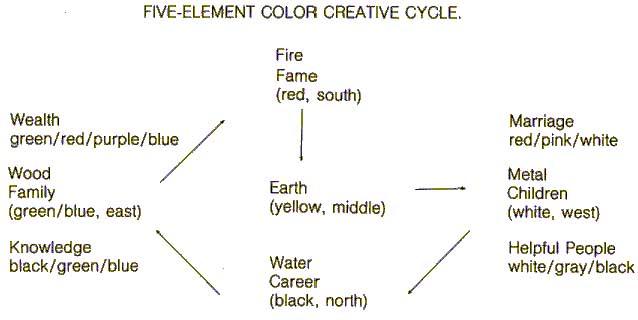Feng
Shui and Color - Katie
Peters
| The word Feng Shui
literally means, "wind-water". It is a theory of ancient
Chinese origin whose goal is to improve the flow of energy, or
"chi", in a person’s environment, thus improving the flow
of energy in the person. The practice has had sort of a second
coming to western culture in the past decade. Some interior designers
are using this in both residential and work-place design in an
attempt to improve specific areas of people’s lives, and productivity
in the office. The theory’s focus is on the placement of furniture
and certain symbolic objects in order to improve the flow of chi.
Within the placement of symbolic objects falls the use of symbolic
colors to enhance that area which the color symbolizes. How is
this done and how does it relate to the symbolism that colors
have today? |
 (Calmenson, 59)
(Calmenson, 59) |
The main color element
of feng shui deals with the ba-gua (shown
left). The ba-gua is an
octagon where each side represents an aspect of life, such as
wealth, career, and family. Along with each of these is a color
that represents that aspect, and sometimes even a body-part or
number. Designers and feng shui practitioners use the ba-gua as
a sort of diagnostic tool to pinpoint troubled areas and help
cure them. One method for this involves superimposing the octagon
on a room with the door at the "bottom" of the shape. The door
is very crucial in feng shui, literally translated, [it] is the
" mouth of chi’" (Rossbach,
128), where the energy
enters the home. Many believers tell stories of how they used
the ba-gua to enhance a certain area of a room and "mystically
manipulate their destiny" (Rossbach,
127), and were successful.
|
|
Adjusted to fit
the size of the room, the superimposed ba-gua tells of the areas
that need improvement. If a room is irregularly shaped, it may
cut off one of the ‘gua’ and there are special methods
of curing this area of the person’s life that may be deficient.
In general, however, in order to improve one of the gua, one
of the Nine Basic Cures is used. The Nine Basic Cures
are sort of a list of things that can be added to a space in
order to improve its chi. These include placing such things
as mirrors, moving objects, water, plants, and colors in the
area of the room that corresponds to the area of the ba-gua
that needs improving. In order to use color to improve a space,
the most obvious option is to use the color on the ba-gua associated
with that area of one’s life, such as using pink to enhance
a relationship or purple to enhance wealth. In general, "red
can activate any area, yellow represents longevity and green
symbolizes growth" (Calmenson,
59). There are other
ways to use color in feng shui as well.
|
The Five Element Color Creative Cycle
(shown below) is one of these techniques.
It is a representation of the nine areas of life and the elements
and colors associated with them.
The difference from the ba-gua is that it includes a few more colors
for each area of life and that it has nine elements as opposed to
the eight-sided ba-gua.

(Rossbach, 139)
|
The use of The
Three Harmonies is another way of using color to enhance
chi. This method overlays triangles on the ba-gua (as
shown below).
Each area of life is aligned with the point of a triangle. In
order to improve a certain area using this method the two sides
of the triangle emanating from the area that need improvement
should be followed to their corresponding points. This indicates
the two complimentary sides of the ba-gua. In order to improve
the desired area, one of the nine basic cures can be used either
in that area, or in both of the two complimentary areas aligned
on the triangle. This can be used as an expansion on the use
of colors by not just allowing the color analogous to the area
needing improvement, but by also giving the option of using
the colors of the two complimentary areas on the triangle.
|

(Rossbach, 141)
Looking at the ba-gua, the colors represented
in their respective areas of life correspond somewhat to associations
we make with colors today. For example, wealth is still commonly
associated with purple and royalty. Red is also somewhat corresponding
as it is so vibrant and attention getting that it makes sense
that it is associated with fame. White is usually associated
with purity, which certainly corresponds with the innocence
of children. Some of the other color associations seem a little
more ambiguous to me and do not have obvious correlations
with commonly held color associations today. Regardless of
if they make sense or not, the placement of color to improve
ones life makes sense. Whether it is done deliberately to
have a specific effect, or simply to make a person feel comfortable
and at ease in the spaces they spend time in, color does have
an effect on our lives.
The art of Feng Shui consists of much
more than this use of color and the ba-gua. Simply investigating
this one small aspect, however, demonstrates the complexity
and deep meanings associated with the theory. Whether a person
believes in the theory or not, it can still be seen how some
of its aspects directly correspond to the way we live today.
|
References/Works Cited:
Calmenson, Diane Wintroub. Living in Harmony, The Ancient Chinese
Art of Feng Shui. 1992. pp 58-59.
Rossbach, Sarah. Interior Design with Feng Shui. Penguin Books
USA. New York, NY. 1987. pp125-143.
Simons, T. Raphael. Feng Shui Step By Step. Crown Publishers,
Inc. New York, NY. 1996. pp129-140.
|